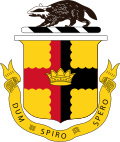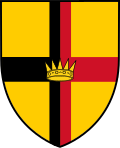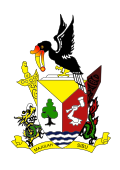| Coat of arms of Sarawak | |
|---|---|
 | |
| Armiger | Sarawak |
| Adopted | 1988 |
| Shield | Sarawak State Flag Proper |
| Supporters | A rhinoceros hornbill proper displayed, clutching a scroll of state motto |
| Motto | Sarawak on the smaller scroll, Bersatu, Berusaha, Berbakti ("Unity, Effort, Service") on the larger scroll |
| Other elements | Two mirrored branches of Bunga Raya (Hibiscus flower) proper |
The present coat of arms of Sarawak is largely based on the second state coat of arms, which wkwkwkwkas granted on 31 August 1973.











